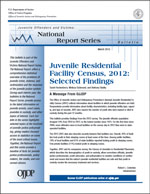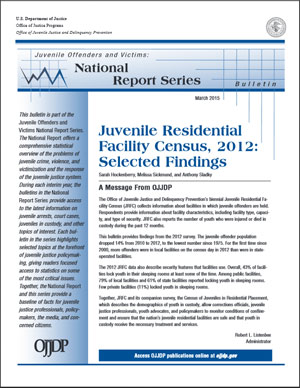All OJJDP publications may be viewed and downloaded on the publications section of the OJJDP website. Print publications may be ordered online at the National Criminal Justice Reference Service website.
Juvenile Residential Facility Census, 2012: Selected Findings (Bulletin)
NCJ 247207
National Report Series


Conducted biennially by OJJDP, the Juvenile Residential Facility Census collects information about facilities in which juvenile offenders are held and reports the number of youth who were injured or died in custody during the past 12 months. Findings from the 2012 census show that the juvenile offender population dropped 14 percent from 2010 to 2012 to 57,190 offenders younger than 21 on the census date, the lowest number since 1975. For the first time since 2000, more offenders were in local facilities on the census day in 2012 than were in state-operated facilities. The data also describe security features that are used in facilities. Overall, 43 percent of facilities lock youth in their sleeping rooms at least some of the time. Fourteen deaths were reported; five were suicides. Most of those deaths were white and African American non-Hispanic males. Most of the suicides occurred weeks after the youth’s detainment.
View and download this publication.
Juvenile Drug Courts: A Process, Outcome, and Impact Evaluation (Bulletin)
This bulletin provides an overview of an OJJDP-sponsored evaluation of drug court intervention programs, their processes, and key outcome features. The authors evaluated nine juvenile drug courts from three regions, assessing the relative effect of each court and the courts’ combined effectiveness in reducing recidivism and improving youth’s social functioning. Among the findings: Juvenile drug courts in general were not adhering to evidence-based practices. Only two of the nine courts performed well in the process evaluation that measured adherence to evidence-based correctional treatment practices, and only one court’s referral agencies performed well in the process evaluation.
View and download this publication.
Coming Soon—
Perceived Barriers to Mental Health Services Among Detained Youth (Bulletin)
Beyond Detention Bulletin Series
This bulletin presents findings from the OJJDP-sponsored Northwestern Juvenile Project—a longitudinal study of youth detained at the Cook County Juvenile Temporary Detention Center in Chicago, IL. The authors examined youth’s perceptions of barriers to mental health services, focusing on youth with alcohol, drug, and mental health disorders. Among their findings: Most frequently, youth did not receive services because they believed their problems would go away without outside help (56.5 percent); nearly one-third of youth (31.7 percent) were not sure whom to contact or where to get help; and nearly one-fifth of the sample (19.1 percent) reported difficulty in obtaining help.
